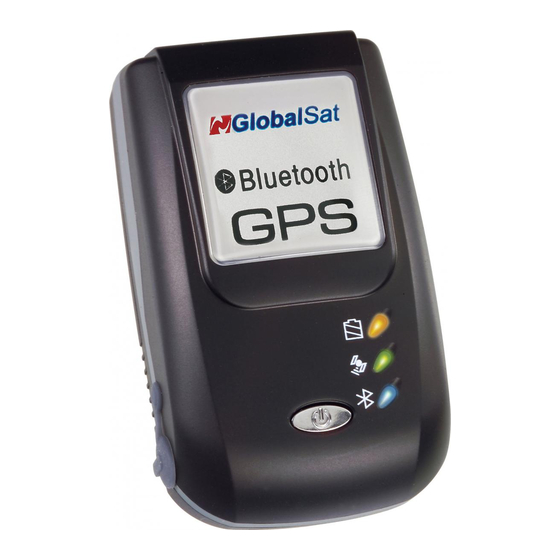Advertisement
Advertisement
Table of Contents

Subscribe to Our Youtube Channel
Summary of Contents for Globalsat BT-338
- Page 1 User Manual Bluetooth GPS Receiver BT-338 ver 1.08...
- Page 2 1 BT-338 at a glance 1.1 Appearance and Function 1.2 How to change battery Figure 1 Open the cover of battery...
- Page 3 Figure 2 Take out the battery with pull tag Figure 3 Put new battery into BT-338...
- Page 4 Figure 4 Fit battery into BT-338 Figure 5 Slide the cover of battery to close Figure 6 Slide the cover of battery to close...
- Page 5 1.3 Accessories...
-
Page 6: Power Switch
2. Introduction The BT-338 is a GPS receiver with Bluetooth interface and built-in active antenna for high sensitivity to tracking signal. Based on the SiRF star III Low power chip set and supports all functions (Single Sat updates in reduced visibility, Superior urban canyon performance, FoliageLock for weak signal tracking, etc.). -
Page 7: Power Jack
LED off ---- Battery is partially full or fully charged. 2.5 Power-saving Function When you start the power of the Bluetooth GPS Receiver BT-338, if the Bluetooth is not connected to any devices within 10 minutes, BT-338 will turn off the power automatically,... -
Page 8: Bluetooth Specification
3. Specification 3.1 System Specification Electrical Characteristics (Receiver) Frequency L1, 1575.42 MHz C/A Code 1.023 MHz chip rate Channels 20 all-in-view tracking Tracking Sensitivity -159 dBm Accuracy Position Horizontal 10m 2D RMS (SA off) WAAS enabled 5m 2D RMS (SA off) Time 1 micro-second synchronized to GPS time Velocity... - Page 9 1. Turn on the power switch in BT-338 2. Please refer to the user manual of PDA to enable the Bluetooth of PDA connecting to the BT-338. Some PDAs may need the Bluetooth passkey, the passkey is “0000”. 3. Check the number of COM port used by Bluetooth.
- Page 10 “0000”. 3. Check the number of COM port used by Bluetooth.(Example COM 6). 4. Running the suitable mapping/navigation software and select the correct COM port & baud rate : 38400. Note: The Bluetooth device in most of the applications have an “auto-detect” feature that you do not need to select the Baud Rate.
-
Page 11: How To Test Your Bluetooth Gps Receiver
5. How to test your Bluetooth GPS Receiver? The testing program only supports the Microsoft Windows CE & Pocket PC based PDA platform. 1. Run the “GPSinfo.exe” to execute the installation procedure of testing program (via PC and ActiveSync). 2. Run the “GPS Information” program from “Start → Program files” of PDA. Here is the description of “GPS Information”... - Page 13 Trouble shooting Bluetooth is unable to connect A) Check if the GPS Bluetooth indicator is flashing normally. That is, flash one per each three second means the product is under standby mode; flash once per second means Bluetooth has been online already. B) Check if energy level is sufficient.
- Page 14 Appendix A: Connect bluetooth GPS receiver with Windows Mobile Version 5 Pocket PC 1. Tap on the bluetooth button on 3. Check “Turn on Bluetooth”. right lower corner. 2. Turn on your Bluetooth GPS receiver. 4. Tap the “Devices” tab, and tap 5.
- Page 15 7. Enter Passkey “0000” and tap 8. Check “Serial Port” and tap Next. Finish. 10. Tap the “COM Ports” tab, and 9. The device will be shown on the select “New Outgoing Port”. list.
- Page 16 11. Select the device and tap Next. 12. Uncheck “Secure Connection” and from the drop down box select a COM port nubmer (for example, COM7), and then tap Finish. 13. The device with it’s COM port 14. Now you can go to GPSinfo number will be shown on the program, set the correct COM list.
-
Page 17: Fcc Notices
FCC Notices This device complies with part 15 of the FCC rules. Operation is subject to the following two conditions: (1)This device may not cause harmful interference, and (2)This device must accept any interference received, including interference that may cause undesired operation . FCC RF Exposure requirements: This device and its antenna(s) must not be co-located or operation in conjunction with any other antenna or transmitter.















Need help?
Do you have a question about the BT-338 and is the answer not in the manual?
Questions and answers